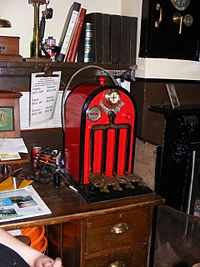Difference between revisions of "Single line working using tokens"
(added history section) |
|||
| Line 1: | Line 1: | ||
[[File:The token machine, Oakworth station, KWVR - geograph.org.uk - 794512.jpg|thumb|200px|right|A token machine similar to those used on the SVR]] Working between [[Bewdley North signal box|Bewdley]] and [[Bridgnorth]] is controlled using tokens, according to the Electric Train Token Regulations. This system ensures that only one train can enter each section of track at any given time. | [[File:The token machine, Oakworth station, KWVR - geograph.org.uk - 794512.jpg|thumb|200px|right|A token machine similar to those used on the SVR]] Working between [[Bewdley North signal box|Bewdley]] and [[Bridgnorth]] is controlled using tokens, according to the Electric Train Token Regulations. This system ensures that only one train can enter each section of track at any given time. | ||
| − | + | == History == | |
| + | Early railways used slow speeds and had frequent passing places, so it was safe for trains to be driven 'on sight' as far as the driver could see was clear. However as speeds and distances between passing places increased, it was quickly found that more complex systems to avoid collisions were needed on single lines. | ||
| − | ==See | + | At first this was done using a unique object called a 'train staff' for each section of line, which the driver of each train was required to carry with him. As there was only one staff for each section, this ensured only one train could be on the line at once. It worked well if trains always alternated in direction, but if two trains in succession were required to travel in the same direction, the token had to be walked back to the start after the first train. Because of this the 'staff and ticket' system developed: the first train would be shown the staff and given a paper or metal 'ticket' to carry on the engine. The final train, in a group travelling in the same direction, would carry the staff. |
| + | |||
| + | With the staff and ticket system, there was little to stop the signalman issuing tickets improperly. Token systems were developed as one way around this problem, using electrically-connected machines called 'token instruments' to hold a set of objects like the earlier train staff, called 'tokens'. The machines were designed to be linked in pairs, with each pair of machines sharing a set of tokens, and designed so that only one token in the set can be removed from the instruments at any time. The first token instruments used metal batons ('electric train staffs') or discs ('tablets'), and tokens always had to be removed from one machine and returned to the other. The SVR uses a later type of instrument called a 'key token' instrument, so named because each token resembles a large key. | ||
| + | |||
| + | == See Also == | ||
[[Acceptance Lever]] | [[Acceptance Lever]] | ||
| + | |||
| + | [[ETT]] | ||
Revision as of 17:37, 25 January 2015
Working between Bewdley and Bridgnorth is controlled using tokens, according to the Electric Train Token Regulations. This system ensures that only one train can enter each section of track at any given time.History
Early railways used slow speeds and had frequent passing places, so it was safe for trains to be driven 'on sight' as far as the driver could see was clear. However as speeds and distances between passing places increased, it was quickly found that more complex systems to avoid collisions were needed on single lines.
At first this was done using a unique object called a 'train staff' for each section of line, which the driver of each train was required to carry with him. As there was only one staff for each section, this ensured only one train could be on the line at once. It worked well if trains always alternated in direction, but if two trains in succession were required to travel in the same direction, the token had to be walked back to the start after the first train. Because of this the 'staff and ticket' system developed: the first train would be shown the staff and given a paper or metal 'ticket' to carry on the engine. The final train, in a group travelling in the same direction, would carry the staff.
With the staff and ticket system, there was little to stop the signalman issuing tickets improperly. Token systems were developed as one way around this problem, using electrically-connected machines called 'token instruments' to hold a set of objects like the earlier train staff, called 'tokens'. The machines were designed to be linked in pairs, with each pair of machines sharing a set of tokens, and designed so that only one token in the set can be removed from the instruments at any time. The first token instruments used metal batons ('electric train staffs') or discs ('tablets'), and tokens always had to be removed from one machine and returned to the other. The SVRSevern Valley Railway uses a later type of instrument called a 'key token' instrument, so named because each token resembles a large key.
